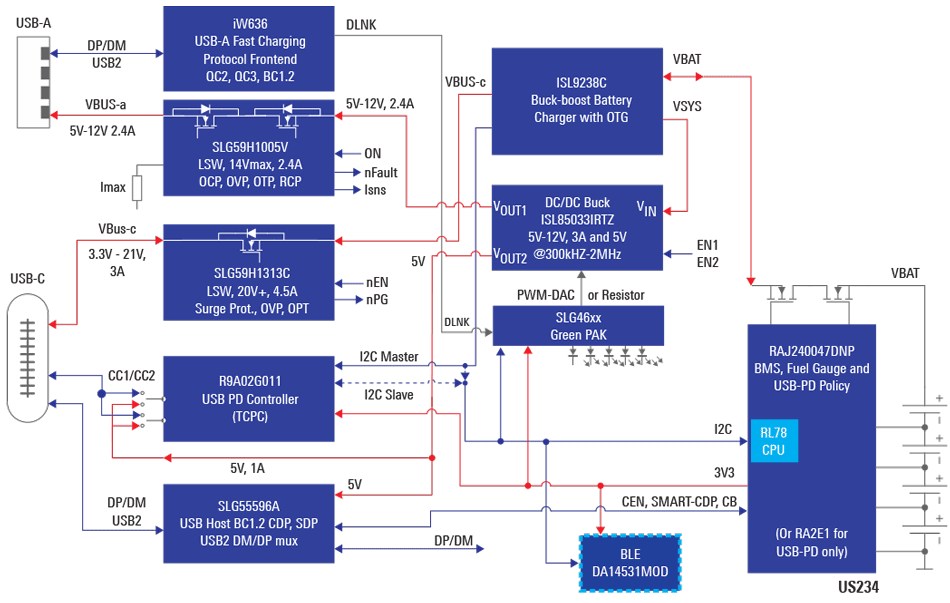Since the release of the USB Power Delivery 3.0 (USB-PD 3.0) specification for the USB Type-C connector, this small, reversible connector has managed to become "the" ubiquitous power and data connector for mobile electronics. It unifies power source and power sink capabilities with both directions of power flow being available in Dual Role Power (DRP) capable devices and a variety of data formats and connections passing through its high-speed data pins.
This universal capability has led to the adoption of USB Type-C by all major mobile device makers as a data and power connector in their mobile phones, tablets and laptop computers. While numerous mobile phones added 30W+ fast charging capabilities and laptop computers typically require a 45W+ power supply for charging and operation, typical power banks using a single cell battery can hardly supply the required energy without compromising on the cycle life of that battery cell.
With most USB Type-C ports and cables today supporting 3A current with a maximum VBUS of 21V in Programmable Power Supply (PPS) mode, 60W of power is a natural limit to be considered for broad market supplies. The table below shows the resulting battery current for different battery stacks (1S to 4S) to provide 20V at 3A (60W), assuming a loss-less conversion. (taking real-life DC/DC boost conversion efficiency into account a lower battery voltage that coincides with the lower efficiency of a converter which would increase the battery current even further).
| Number of Stacked Batteries | Voltage Range [V] Min - (Nom) - Max |
Current at 60W (20V, 3A) Min - (Nom) - Max |
|---|---|---|
| 1 | 3.0 – (3.6) – 4.2 | 20 – (16.7) – 14.3 |
| 2 | 6.0 – (7.2) – 8.4 | 10 – (8.3) – 7.1 |
| 3 | 9.0 – (10.8) – 12.6 | 5 – (5.6) – 4.8 |
| 4 | 12.0 – (14.4) – 16.8 | 2.5 – (4.2) – 3.6 |
Table 1. Battery current as a function of the battery stack size for 60W (20V at 3A) output
The excessively high current for the 1S and 2S solution would result in additional resistive power losses and self-heating of the unit in comparison with a 3S or 4S design which is the reason we decided to focus on a 4S-based solution.
The Renesas "Multi-Cell USB-PD + QC2 & QC3 Power Bank" winning combination solution is a USB-PD enabled power bank solution using a multi-cell battery stack. It supports USB Power Delivery 3.0 with up to 21V for PPS and 3A in this specific solution with full support of DRP. An additional legacy 2.4A capable USB Type-A port supports Qualcomm Quick Charge 3.0 using our iW636 USB Type-A fast charging protocol frontend.
The power bank system is controlled by our R9A02G011 USB-PD controller and its integrated processor enabling easy customization of supported features and system behavior. Since it supports marked cables, this architecture can also support USB-PD power profiles up to 100W.
Renesas’ integrated Battery Management System (BMS) and fuel-gauge RAJ240047 is used for battery monitoring and control. An integrated 16-bit RL78 core allows customer-specific battery monitoring and control algorithms to be used.
Depending on the targeted user interface, a GreenPAK™ programmable mixed-signal matrix can be used to expand the number of supported LEDs for bar-graph displays and similar. Both VBUS rails are protected using highly integrated load switches adding their own layer of system protection, ranging from overvoltage and current to surge protection to this design.
An optional Bluetooth® Low Energy (LE) interface using a DA14531 system-on-chip (SoC) enables OS-independent power bank monitoring, control and tracking.

